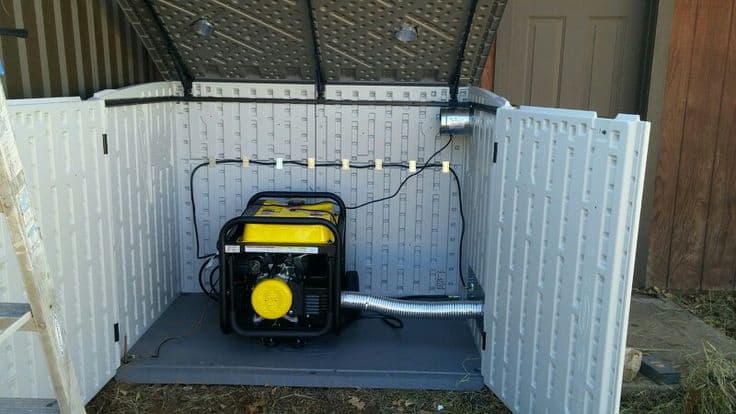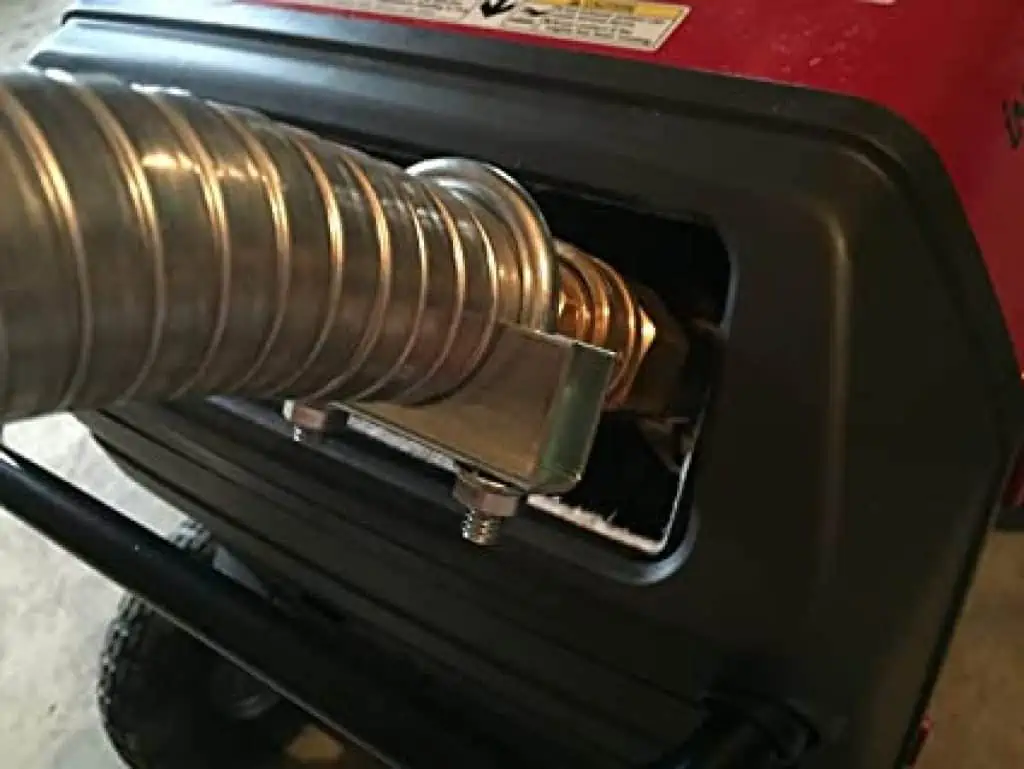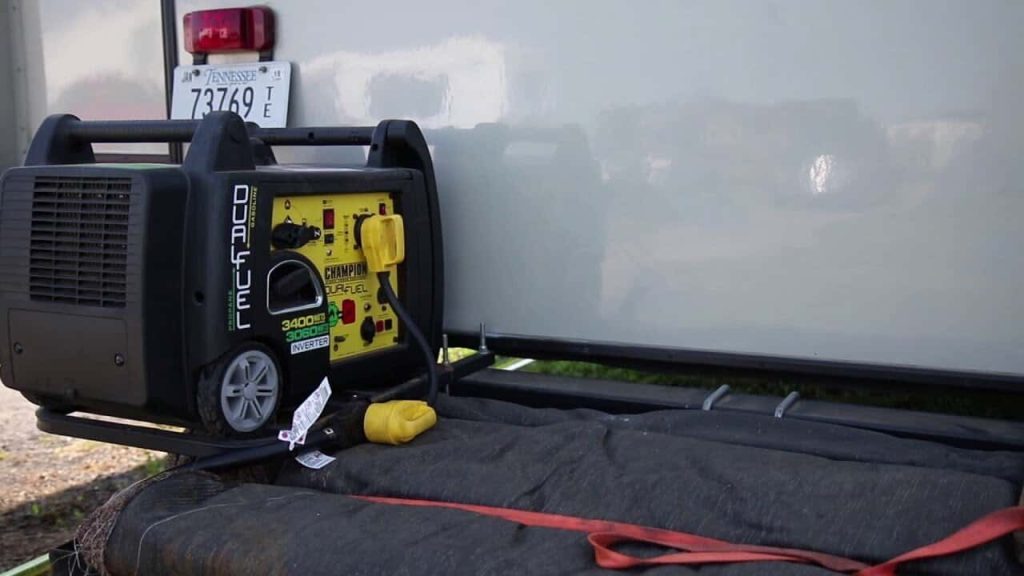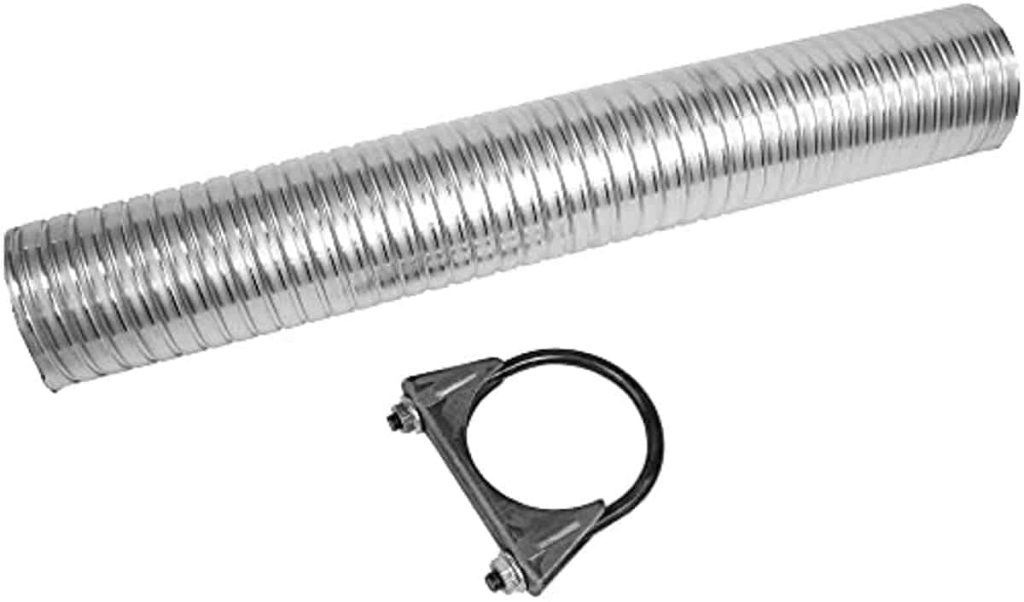
Generators should be installed outside because they can produce deadly carbon monoxide (CO) levels. The toxic emission passes through the generator’s exhaust, so it is advisable to position the exhaust away from your home.
Extending and Positioning Generator Exhaust
To keep the generator safe outside, it is advisable to place it in a generator shed. The generator shed should be well-ventilated, and the exhaust should be positioned correctly. To further protect yourself and your family from the toxic emission, you can extend your generator’s exhaust.

When extending the generator exhaust, you have the option to hire a professional, or you can do it yourself.
DIY Generator Exhaust Extension

Tools In Extending Generator Exhaust
- Ruler/tape measure
- Vernier caliper (recommended)
- Screwdriver
- Small socket
- Drill (possibly for an exterior hole in the shelter)
What You Need To Do
- To purchase the proper extension kit or the correct parts for your DIY project, you’ll need to know the specific measurements of the generator exhaust. If the components you order do not match, the project will be scrapped before it even gets started.
- Additionally, the length of the extension should be considered. How far does the pipe have to be extended so that the generator’s exhaust is directed away from the building? It needs to extend out into the air by a few inches from the shelter.
- While a ruler can be useful for making rough estimates, a vernier caliper is essential for accurate measurements.
- You should add 0.07 centimeters for the length of the extension. This ensures that the extension fits appropriately without being so tight that it is difficult to put it on. A clamp-like mechanism will be used to ensure that no leaks occur.
- Choose the extension tube or pipe based on the exhaust measurement you took from the generator. Dual- and single-exhaust extension generators are available. The first is a flexible plastic tube, and the second is a rigid steel pipe.
- The length and diameter of the flex tube are also adjustable. Since the flex tube is made of metal, it will not melt under the intense heat of the exhaust.
Walker 36326 Pipe-Flex Exhaust Kit

Steel pipe is available in a wide variety of grades and pricing points. It is recommended that the pipe be installed in a straight line from the exhaust of the generator to the exterior of the shelter unless you have the tools necessary to bend the pipe.
Like the flex tubing, it is widely available at hardware stores, Amazon, and auto parts outlets.
Now that you know how long your generator’s exhaust pipe has to be, you can decide whether to buy a kit or do the job yourself.
How to Put The Exhaust Extension
Clean the generator’s exhaust.
If the generator has been used before, the exhaust must be cleaned before the extension is installed. It’s important to clean the area thoroughly of any carbon and oily filth before putting in the new parts. A clean surface makes it easier for new parts to fit firmly and prevent loosening.
Connect the clamp.
The exhaust extension tube can be safely attached with a pipe clamp. On the market, you can find two distinct varieties of clamps. Pipe and hose clamps, respectively. The flex tube and the pipe clamp are the ideal combinations for this application.
Before you can attach the pipe clamp to the generator’s exhaust, you’ll need to loosen the two screws holding it in place with a socket or screwdriver. When positioning it around the generator’s exhaust, leave enough space for it to move onto the flex tube.
Attach the extension.
Installation is simple when the correct size tube has been measured and purchased. Put it on the exhaust of the generator in a secure manner. Remember that the tubing shouldn’t be more than 0.07 centimeters (0.02 inches) greater in diameter than the exhaust it connects to.
Pull the flex tubing through the pipe clamp. To tighten the pipe clamp’s screws, you’ll need a socket or a screwdriver. To achieve this, you should tighten the extension to the point where it will not fall off when you jiggle it. Overtightening can cause the exhaust pipe and the extension flex tube to get damaged.
Extend through the wall of the shelter.
Even though exhaust holes may already be cut into your shelter, you may need to make one yourself. It needs to be level with the generator’s exhaust for the extension to fit.
The exhaust extension will get hot (between 300 and 500 degrees) when the generator is on, so make sure the material around the exhaust hole is fireproof.
Putting Things to the Test

When extending the exhaust, keep in mind that it needs to go out from the shelter by at least a few inches. It should be far from windows and entrances to prevent carbon monoxide from entering.
The generator’s exhaust extension will be tested as the final step. In this way, you can rest assured that your work is error-free.
Let the generator run for 10 minutes after turning it on. Inspect the flex tube for leaks at the point of installation, and everywhere it connects to the exterior. Is there any exhaust smell that sticks around because of the lack of air circulation? Is the extension securely attached?
Considerations
Some people believe that adding an extension to the generator’s exhaust will reduce noise. It will not unless you also put in soundproofing measures, such as a muffler. It is important to keep in mind that this is not a muffler but rather an extension of the exhaust. Consider constructing or purchasing a quiet box for your generator if you need to lower the volume. The generator’s noise will follow the pipe or tube as it extends underground.
If your generator is installed in a fixed location (like a shelter), you probably won’t need to remove the exhaust extension unless it’s in the way. However, you should disconnect the extension if the generator is going to be transported or stored between usage. The generator will be able to be stored more conveniently as a result.
To accomplish this, you will need to loosen the pipe clamp screws and remove the flex tube extension. Take care not to damage the flex tube while storing it.
FAQS
How can I extend a generator’s exhaust?
You can extend the exhaust of your generator by purchasing an extension kit. You are going to need a flex tube to extend the exhaust. You can do it yourself or hire a professional.
Is it possible to pipe the generator exhaust?
Your generator’s location will determine whether you require an exhaust extension. Use an exhaust extension kit or buy the parts separately. This program will divert the fumes to a safe, well-ventilated place.
Can I have my generator fitted with a muffler to reduce the noise it makes?
A muffler or baffles can be attached to an exhaust extension for a generator to reduce noise. Compared to a generator shelter (sound box), which can reduce noise by as much as 10-15 dB, this may help your generator run more quietly. An extension with baffles or a muffler can be combined with a shelter to reduce sound further.
A generator may produce a noise of around 75 dB. The average volume of human speech is approximately 60 dB.
How can I reduce the noise level of my generator?
If you put your generator within a shelter, you can cut the noise by as much as 10 to 15 dB. A generator can generate roughly 75 decibels of noise. Again, a quiet box is highly recommended if you wish to reduce the volume of your generator.
Could I use a vent to put my generator in the garage?
Generator manufacturers strongly advise against using their products inside garages. Carbon monoxide poisoning is the most important health risk to avoid. A minor leak may still introduce harmful gas into a closed space, even if ventilation is in place. Remember that CO has no taste or smell and can pass undetected.
As an added safety precaution, carbon monoxide can also be combustible. Just one little spark could start a fire.


